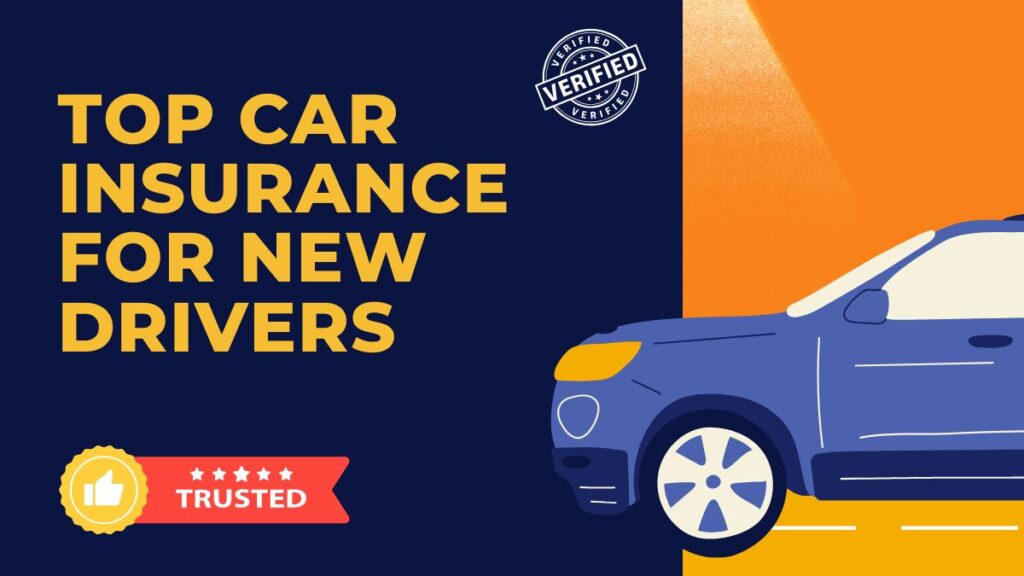What makes the best car insurance for new drivers, and how can you find affordable car insurance for new drivers that meets your needs? There are many options out there. It’s important to compare quotes and find the right coverage.
Travelers, Auto-Owners, State Farm, and USAA are among the top car insurance companies for new drivers. They offer competitive pricing and complete coverage.
As a new driver, finding the right car insurance can be overwhelming. But with the right information, you can make a good choice. The average annual cost for full coverage insurance is $1,291. The average monthly cost for full coverage insurance is $108.
In this article, we will review the top car insurance companies for new drivers. We will also provide tips for finding the best car insurance for new drivers and affordable car insurance for new drivers.
Understanding Car Insurance Requirements for New Drivers
As a new driver, knowing the car insurance rules in your state is key. Each state has its own set of mandatory coverages. For instance, in Illinois, you must have at least $25,000 in bodily injury liability insurance per person and $50,000 total per accident. You also need $20,000 in property damage liability insurance per accident.
New drivers might also want to look into extra coverage options. These include personal injury protection, uninsured motorist coverage, and roadside assistance. These can offer more protection and peace of mind while driving. Here are some important points to remember:
- Liability coverage: covers damages to other people and property in an accident
- Collision coverage: covers damages to your vehicle in an accident
- Comprehensive coverage: covers damages to your vehicle from non-accident events, such as theft or vandalism
- Personal injury protection: covers medical expenses for you and your passengers in an accident
- Uninsured motorist coverage: covers damages if you’re involved in an accident with an uninsured driver
Car insurance needs for new drivers can change based on the state and insurance company. It’s vital to research and compare different policies. This way, you can find the best fit for your needs and budget.
Factors Affecting Insurance Rates for Inexperienced Drivers
As a new driver, knowing what affects your car insurance rates is key. Insurance companies see new drivers as riskier, leading to higher rates. Your age, driving experience, and the type of vehicle you drive all play a part.
For instance, teen drivers face an average of $5,985 a year for full coverage. Drivers over 25 pay about $2,216 annually. The vehicle you drive also matters, with sports cars and luxury cars costing more to insure than sedans or SUVs.
Here are the main factors that influence insurance rates for new drivers:
- Age: Younger drivers, like teens, are seen as riskier and pay more.
- Driving experience: New drivers with little experience pay more than those with more experience.
- Vehicle type: The make and model of your vehicle can also affect your insurance rates, with some being more expensive to insure.
Knowing these factors can help new drivers choose better car insurance. This might help lower their rates.
Best Car Insurance for New Drivers: Top Providers of 2025
Looking for the best car insurance for new drivers? There are several top providers to check out. Travelers, Auto-Owners, State Farm, and USAA are among the best. They offer various coverage options and discounts to help new drivers save money.
Top Car Insurance Providers
The top car insurance providers for new drivers include:
- Progressive
- Geico
- State Farm
- USAA
These providers offer low premiums compared to the national average. For example, the national average for 20-year-old drivers is $5,374 per year for full coverage. Companies like Progressive and Geico have even lower rates.
| Company | Average Annual Rate for Minimum Coverage |
|---|---|
| Geico | $243 per year |
| State Farm | $511 per year |
| USAA | $626 per year |
New drivers should research and compare the best car insurance companies. This helps find the most affordable and complete coverage.
Budget-Friendly Insurance Options for First-Time Drivers
Finding affordable car insurance as a new driver can be tough. But, by comparing quotes and looking for discounts, you can cut down on costs. Some companies give discounts for good grades, military service, or defensive driving courses.
The average monthly rate for new drivers under 25 is $544. Yet, State Farm offers full coverage for this age group at just $276. That’s about half the average. Allstate also has a full coverage option for $374. The cheapest rate from Allstate for minimum coverage is $100.
Here are some key statistics to consider when searching for affordable car insurance for new drivers:
- Average monthly rate for new drivers under 25: $544
- Full coverage cost from State Farm for drivers under 25: $276
- Full coverage cost from Allstate for drivers under 25: $374
- Cheapest minimum coverage rate from Allstate for drivers under 25: $100
To find the best budget-friendly insurance options, compare quotes from different companies. Look for discounts too. This way, new drivers can save money and find affordable insurance that fits their needs.
| Insurance Company | Full Coverage Rate for Drivers Under 25 | Minimum Coverage Rate for Drivers Under 25 |
|---|---|---|
| State Farm | $276 | $129 |
| Allstate | $374 | $100 |
| Geico | $296 | $131 |
Special Programs and Features for New Drivers
New drivers can find special programs and features from insurance companies. These can help them save money and get better at driving. One example is usage-based insurance, which rewards safe driving.
Insurance companies also offer discounts for new drivers. For instance, Liberty Mutual gives a discount for students with a B or higher GPA. Young drivers might get a discount if they were recently added to a policy.
Usage-Based Insurance Programs
Usage-based insurance programs, like GEICO’s DriveEasy, track a driver’s habits. They offer up to 10% discounts for safe driving. Over 260,000 teen drivers have joined GEICO’s program, with 75% getting a discount after renewal.
Safe Driver Apps and Tracking Devices
Safe driver apps and devices help new drivers improve their skills and lower insurance costs. They track speed, acceleration, and braking. This feedback can help new drivers qualify for discounts.
Educational Course Discounts
Educational course discounts are another way for new drivers to save. Many companies offer discounts for defensive driving courses. These courses teach safe driving habits and lower accident risks.
Comparing Coverage Types and Their Benefits
When looking at car insurance, it’s key to compare different types. You’ll find options like liability, collision, and full coverage. Each has its own good and bad points. By comparing, new drivers can choose wisely.
Here’s how to compare car insurance types:
- Cost: Each coverage costs differently. Comparing helps find the cheapest.
- Coverage: Coverage levels vary. Comparing helps pick the right one for you.
- Benefits: Each coverage has its own perks. Comparing helps find the most beneficial one.
Let’s look at the differences in car insurance types with a table:
| Type of Coverage | Description | Cost |
|---|---|---|
| Liability Coverage | Covers damages to others in an accident | Varies by state |
| Collision Coverage | Covers damages to your vehicle in an accident | $200-$500 per year |
| Comprehensive Coverage | Covers damages to your vehicle from non-accident events | $100-$300 per year |
By comparing car insurance types and their benefits, new drivers can make a smart choice. They can find the best coverage for their needs.
How to Save Money on New Driver Insurance
Many new drivers want to save on car insurance. The average cost of adding a teenager to a policy is $3,824 a year. It’s key to look for ways to lower premiums.
Car insurance discounts can help a lot. For example, good grades, military service, or a defensive driving course can cut costs. These discounts can make a big difference.
Available Discounts and Promotions
- Good student discounts: up to 25% savings for students with good grades
- Defensive driving course discounts: up to 10% savings for completing a course
- Low-mileage discounts: up to 30% savings for drivers with low annual mileage
Bundle Options and Family Plans
Getting insurance policies together or adding a new driver to a family plan can save money. But, rates might go up. On average, adding a teen can increase a parent’s premium by 152%.
| Insurance Scenario | Average Annual Cost |
|---|---|
| Two-adult policy | $2,711 |
| Adding a 16-year-old to a two-adult policy | $6,535 |
| Teen driving an older car in a two-adult household | $5,941 |
By looking into these options and using discounts, new drivers can cut their insurance costs. This makes it easier to manage expenses.
Technology and Insurance: Modern Solutions for New Drivers
Technology is changing how insurance companies work and help new drivers. Telematics devices and mobile apps let them track driving habits. This has led to new ways to insure new drivers.
Recently, more people are joining usage-based insurance (UBI) programs. A J.D. Power study found that UBI program use has doubled, reaching 17% of US auto insurance customers. This growth is because people want more accurate risk assessments and lower costs.
Key benefits of UBI programs include: * Personalized coverage based on driving habits * Lower premiums * More control over insurance costs * Detailed driving data and insights
As technology gets better, we’ll see more new solutions for drivers. Connected vehicles and advanced data analytics will help insurance companies offer better coverage. This means new drivers can get more affordable and personalized insurance.
| UBI Program Benefits | Description |
|---|---|
| Personalized Coverage | Coverage options based on individual driving habits |
| Potential Premium Savings | Lower premiums for safe driving habits |
| Increased Transparency | Access to detailed driving data and insights |
Common Mistakes to Avoid When Selecting Coverage
Choosing the right car insurance is key to avoiding financial trouble. One big mistake is not checking policy exclusions well. These can differ a lot between companies. Not knowing what’s not covered can lead to big surprises, making it vital to read policy details carefully.
Another mistake is picking the minimum coverage to save money. While it might cut costs by 10-20%, it leaves you exposed in big accidents. Policies with low monthly costs often have high deductibles, like $1,000 to $2,500. This can be a big financial hit if you need to make a claim.
Read also: AAA Car Insurance vs Geico
Key Considerations to Keep in Mind
- Policy exclusions can vary significantly between companies, stressing the need for careful review.
- Low monthly premiums often come with high deductibles, potentially leading to financial burdens.
- Discounts for maintaining a clean driving record can reduce premiums by up to 25%.
- Bundling multiple policies may lead to discounts of 10-15% on each policy.
To steer clear of common car insurance mistakes, it’s important to look closely at policy exclusions. Also, think about deductibles, discounts, and whether bundling policies is a good idea. This way, drivers can make smart choices and avoid financial traps, getting the right coverage without spending too much.
| Discount Type | Potential Savings |
|---|---|
| Clean Driving Record | Up to 25% |
| Bundling Multiple Policies | 10-15% per policy |
| Shopping Around for Quotes | Average of $600 per year |
Steps to Purchase Your First Car Insurance Policy
Buying car insurance can be easy if you know the steps. First, figure out how much coverage you need. Also, find out what your state requires. The average cost for new drivers is $2,329 a year, or $194 a month as of August 2024.
To get the best coverage, compare quotes from different companies. Many insurers offer discounts. These can include discounts for good grades, defensive driving, or having more than one policy.
Here are some steps to consider when buying car insurance:
- Research and compare insurance quotes from different companies
- Check for available discounts, such as good student discounts or multi-policy discounts
- Review and understand the policy’s coverage limits and deductibles
- Ask about additional features, such as roadside assistance or rental car coverage
When you buy your first car insurance, it’s important to understand the policy. This ensures you have the right coverage for your needs. By following these steps, you can find a good first car insurance policy that fits your budget.
| Insurance Type | Average Annual Cost | Average Monthly Cost |
|---|---|---|
| Full Car Insurance | $2,329 | $194 |
| Minimum Coverage | $633 | $53 |
Understanding Claims Process for New Drivers
As a new driver, dealing with car insurance claims can feel daunting. You’ll need to report the accident, provide documents, and wait for the claim to be processed. Filing a claim is key to getting compensation for damages or injuries from an accident.
The claims process changes by state. Some states follow a fault-based system, while others use a no-fault system. In fault-based systems, you file against the at-fault driver’s insurance. No-fault states cover your damages, no matter who’s at fault. Knowing your state’s rules is important when filing a claim.
Filing Your First Claim
To start, report the accident to your insurance and give them all the details. This includes a police report and photos of the scene. The time to file claims varies, but most states give you 1 to 3 years. It’s best to tell your broker or insurance within a week or as soon as you can.
What to Expect After an Accident
After you file, the insurance will look at your case and decide on damages or injuries. They might check up to 15 pieces of evidence, like photos and medical records. The time to process claims varies, but it’s usually a few weeks. It can take longer if they need more information.
Some important things to remember about car insurance claims include:
- About 12% of drivers don’t have insurance, so you need uninsured motorist coverage.
- 25% of accidents need police to document them and help with claims.
- Car insurance costs can go up by about 30% for new drivers after an accident.
- Photos of the accident and vehicle damage help get claims approved faster.
The Future of New Driver Insurance Beyond 2025
The future of car insurance is evolving with new tech and solutions. Beyond 2025, new driver insurance will focus more on personal coverage. This change comes with the rise of self-driving cars and telematics devices.
In California, the auto insurance rules are getting tougher. Starting in 2025, the minimum insurance for injuries or death will go up by 100%. For property damage, it will increase by 200%. This is to help cover more costs from accidents.
Several factors will influence new driver insurance in the future. These include: * More use of artificial intelligence for custom coverage * Higher demand for telematics and usage-based insurance * Increased auto insurance rules in states like California * More focus on teaching safe driving and education
As car insurance keeps changing, it’s vital for new drivers to keep up. Knowing about these trends helps young drivers choose the right coverage. This way, they can stay safe on the road.
| State | Current Minimum Auto Insurance Requirements | New Minimum Auto Insurance Requirements (2025) |
|---|---|---|
| California | $15,000 for injury or death to one person, $30,000 for injury or death to more than one person, $5,000 for property damage | $30,000 for injury or death to one person, $60,000 for injury or death to more than one person, $15,000 for property damage |
Conclusion
As we conclude our look at the best car insurance for new drivers in 2025, it’s clear that finding affordable coverage is key. Young drivers can find good policies by using discounts and bundling. They can also use technology to save money.
The car insurance industry is always changing, bringing new benefits for young drivers. By staying up-to-date and proactive, new drivers can feel secure on the road. They know they have the insurance they need to stay safe.
FAQ
What are the mandatory coverage types required for new drivers in different states?
States require different coverages for new drivers. Most need liability, collision, and comp coverage.
What additional coverage options should new drivers consider?
New drivers might want personal injury protection, uninsured motorist, and roadside help.
How do insurance companies determine rates for new drivers?
Rates for new drivers depend on age, experience, and vehicle type. They’re seen as higher risk.
What are the top car insurance companies for new drivers?
Top companies for new drivers include Travelers, Auto-Owners, State Farm, and USAA. They offer various options and discounts.
How can new drivers find budget-friendly insurance options?
New drivers can save by comparing quotes, finding discounts, and using promotions.
What special programs and features do insurance companies offer for new drivers?
Companies offer usage-based insurance and safe driver apps. These help save money and improve driving.
How can new drivers compare different coverage types and their benefits?
New drivers should compare liability, collision, and comp coverage. This helps find the best fit for their budget and needs.
What are some common mistakes to avoid when selecting car insurance coverage?
Avoid not reading policy exclusions. This can cause unexpected costs.
What are the steps to purchase a first car insurance policy?
First, determine the needed coverage. Then, compare quotes and choose the best policy for you.
How can new drivers navigate the claims process?
Report the accident to your insurance, provide needed documents, and wait for processing.


